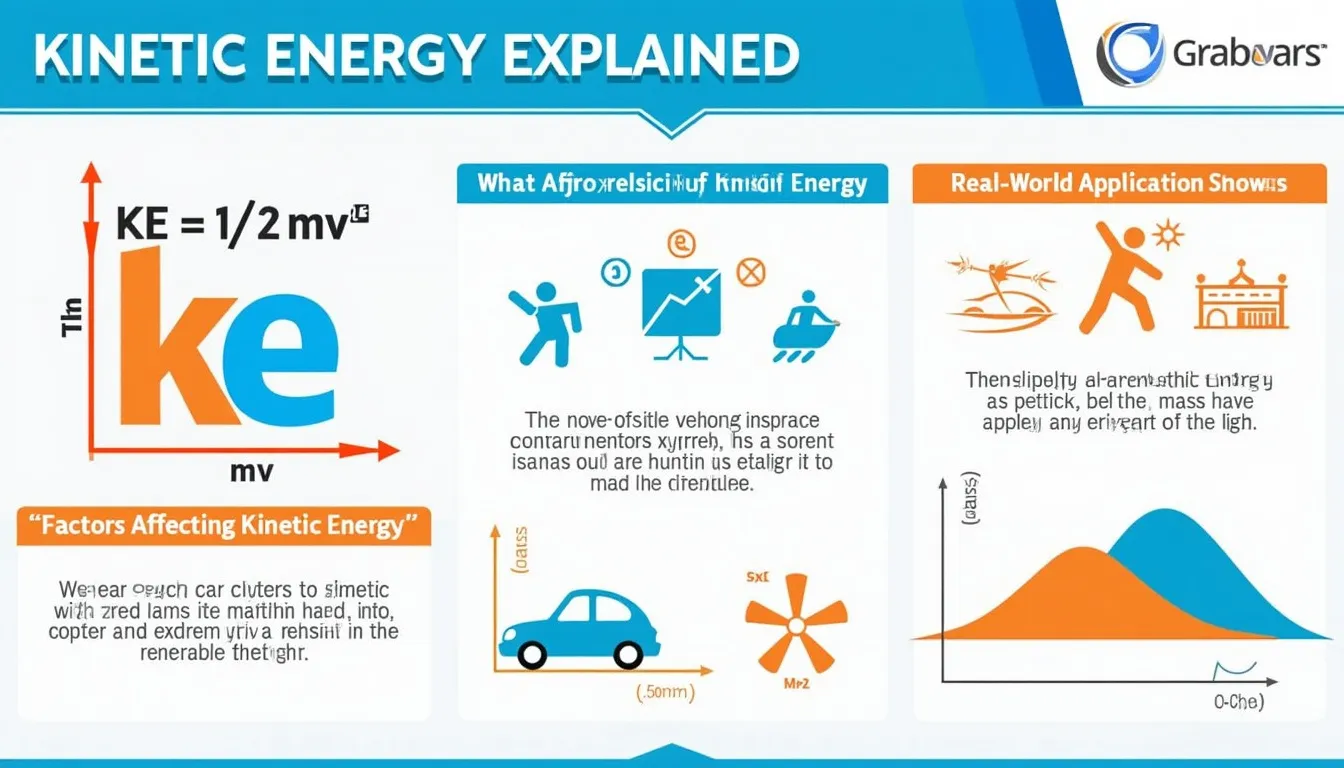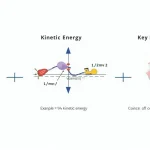Kinetic Energy Calculator
Is this tool helpful?
Welcome to our comprehensive Kinetic Energy Calculator, a powerful tool designed to help you explore the fascinating world of motion and energy. Whether you’re a student, educator, or curious mind, this calculator will assist you in understanding and quantifying the energy possessed by objects in motion.
How to Use the Kinetic Energy Calculator Effectively
Our user-friendly Kinetic Energy Calculator is designed for simplicity and accuracy. Follow these steps to harness its full potential:
- Enter the mass: Input the mass of the object in kilograms (kg) in the first field.
- Input the velocity: Enter the velocity of the object in meters per second (m/s) in the second field.
- Calculate: Click the “Calculate” button to obtain the kinetic energy result.
- View the result: The calculated kinetic energy will be displayed in joules (J) below the form.
It’s that simple! Now you can explore various scenarios by changing the mass and velocity values to see how they affect kinetic energy.
Understanding Kinetic Energy: Definition, Purpose, and Benefits
Kinetic energy is a fundamental concept in physics that describes the energy possessed by an object due to its motion. It is a scalar quantity, meaning it has magnitude but no direction. The amount of kinetic energy an object has depends on two factors: its mass and its velocity.
The Mathematical Formula for Kinetic Energy
The kinetic energy (KE) of an object is calculated using the following formula:
$$KE = \frac{1}{2} \times m \times v^2$$Where:
- KE is the kinetic energy in joules (J)
- m is the mass of the object in kilograms (kg)
- v is the velocity of the object in meters per second (m/s)
This formula shows that kinetic energy is directly proportional to the mass of the object and the square of its velocity. This means that doubling the mass will double the kinetic energy, but doubling the velocity will quadruple the kinetic energy!
The Purpose of Calculating Kinetic Energy
Understanding and calculating kinetic energy serves several important purposes:
- Quantifying motion: It provides a numerical value to the energy of moving objects, allowing for comparisons and analysis.
- Energy conservation: It helps in understanding energy transformations and conservation in various systems.
- Safety considerations: In fields like transportation and sports, knowing the kinetic energy involved can help in designing safety measures.
- Engineering applications: It’s crucial in designing machines, vehicles, and structures that involve moving parts or objects.
- Scientific research: It plays a vital role in numerous areas of physics, from particle physics to astrophysics.
Benefits of Using the Kinetic Energy Calculator
Our Kinetic Energy Calculator offers numerous benefits to users across various fields:
- Time-saving: Quickly compute kinetic energy without manual calculations.
- Accuracy: Eliminate human error in calculations, ensuring precise results.
- Educational tool: Helps students and educators explore the relationship between mass, velocity, and kinetic energy.
- Versatility: Applicable in various fields, from physics and engineering to sports science.
- Accessibility: Available online, making it easy to use anytime, anywhere.
- Visualization: Helps in understanding abstract concepts by providing concrete numerical results.
- Problem-solving: Assists in solving complex physics problems involving kinetic energy.
Addressing User Needs and Solving Specific Problems
Our Kinetic Energy Calculator addresses several user needs and solves specific problems in various domains:
1. Education and Learning
For students and educators, the calculator serves as an invaluable learning tool. It helps in:
- Reinforcing the concept of kinetic energy through practical application
- Demonstrating the relationship between mass, velocity, and kinetic energy
- Providing a quick way to check answers in homework and exams
- Facilitating exploration of “what-if” scenarios by easily changing variables
2. Scientific Research
Researchers in various scientific fields can benefit from the calculator by:
- Quickly estimating kinetic energy in experimental setups
- Verifying theoretical calculations with practical values
- Exploring energy transformations in complex systems
3. Engineering and Design
Engineers and designers can utilize the calculator for:
- Estimating impact forces in collision scenarios
- Designing energy absorption systems in vehicles
- Calculating power requirements for moving machinery
- Optimizing the efficiency of kinetic energy recovery systems
4. Sports and Athletics
In the world of sports, the calculator can be used for:
- Analyzing the energy involved in various athletic movements
- Optimizing equipment design for better performance and safety
- Studying the biomechanics of different sports techniques
5. Transportation and Safety
The calculator proves useful in transportation and safety applications by:
- Estimating stopping distances for vehicles
- Designing more effective crash barriers and safety systems
- Analyzing the energy involved in various transportation modes
Practical Applications and Examples
To illustrate the practical applications of our Kinetic Energy Calculator, let’s explore some real-world examples:
Example 1: Car Safety
Consider a car weighing 1500 kg traveling at 20 m/s (approximately 72 km/h or 45 mph). Using our calculator:
- Mass (m) = 1500 kg
- Velocity (v) = 20 m/s
- Kinetic Energy = 0.5 × 1500 × 20² = 300,000 J or 300 kJ
This calculation helps automotive engineers design appropriate safety features to absorb this energy in the event of a collision.
Example 2: Sports Performance
Let’s calculate the kinetic energy of a 0.15 kg baseball thrown at 40 m/s (about 90 mph):
- Mass (m) = 0.15 kg
- Velocity (v) = 40 m/s
- Kinetic Energy = 0.5 × 0.15 × 40² = 120 J
This information can be used to analyze pitching performance and design protective gear for players.
Example 3: Renewable Energy
Consider a wind turbine blade with a mass of 6000 kg rotating at 12 m/s at its tip:
- Mass (m) = 6000 kg
- Velocity (v) = 12 m/s
- Kinetic Energy = 0.5 × 6000 × 12² = 432,000 J or 432 kJ
This calculation helps engineers optimize the design of wind turbines for maximum energy capture.
Frequently Asked Questions (FAQ)
1. What is kinetic energy?
Kinetic energy is the energy possessed by an object due to its motion. It depends on the object’s mass and velocity.
2. What are the units of kinetic energy?
Kinetic energy is typically measured in joules (J) in the International System of Units (SI).
3. How does doubling the velocity affect kinetic energy?
Doubling the velocity quadruples the kinetic energy because kinetic energy is proportional to the square of velocity.
4. Can kinetic energy be negative?
No, kinetic energy is always positive or zero. It can never be negative because it’s calculated using squared velocity.
5. What’s the difference between kinetic and potential energy?
Kinetic energy is the energy of motion, while potential energy is stored energy due to an object’s position or configuration.
6. How accurate is this Kinetic Energy Calculator?
Our calculator provides results to two decimal places. However, the accuracy of the result depends on the precision of the input values.
7. Can this calculator be used for relativistic speeds?
No, this calculator uses the classical formula for kinetic energy, which is accurate for speeds much lower than the speed of light. For speeds approaching the speed of light, relativistic formulas must be used.
8. Is there a maximum limit to kinetic energy?
Theoretically, there’s no upper limit to kinetic energy. However, as an object approaches the speed of light, its kinetic energy increases dramatically, requiring enormous amounts of energy for further acceleration.
9. How is kinetic energy related to work?
The work done on an object is equal to the change in its kinetic energy. This is known as the work-energy theorem.
10. Can I use this calculator for objects moving in any direction?
Yes, the direction of motion doesn’t affect kinetic energy. Only the magnitude of velocity (speed) matters.
Please note that while we strive for accuracy, we cannot guarantee that the webtool or results from our webtool are always correct, complete, or reliable. Our content and tools might have mistakes, biases, or inconsistencies.
Conclusion: Harnessing the Power of Kinetic Energy Calculations
Our Kinetic Energy Calculator is a powerful tool that brings the abstract concept of energy in motion into tangible, numerical reality. By providing quick, accurate calculations, it serves as an invaluable resource for students, educators, researchers, engineers, and curious minds across various fields.
Key benefits of using our calculator include:
- Time-saving and error-free calculations
- Enhanced understanding of the relationship between mass, velocity, and energy
- Practical applications in fields ranging from physics and engineering to sports and transportation
- Accessibility and ease of use for both beginners and experts
Whether you’re solving homework problems, designing safety systems, optimizing athletic performance, or exploring the fundamentals of physics, our Kinetic Energy Calculator is here to support your journey of discovery and innovation.
We encourage you to explore different scenarios, experiment with various mass and velocity combinations, and deepen your understanding of kinetic energy. Remember, in the world of physics, knowledge truly is power – kinetic power!
Start calculating now and unlock the energetic secrets of motion with our Kinetic Energy Calculator!
Important Disclaimer
The calculations, results, and content provided by our tools are not guaranteed to be accurate, complete, or reliable. Users are responsible for verifying and interpreting the results. Our content and tools may contain errors, biases, or inconsistencies. We reserve the right to save inputs and outputs from our tools for the purposes of error debugging, bias identification, and performance improvement. External companies providing AI models used in our tools may also save and process data in accordance with their own policies. By using our tools, you consent to this data collection and processing. We reserve the right to limit the usage of our tools based on current usability factors. By using our tools, you acknowledge that you have read, understood, and agreed to this disclaimer. You accept the inherent risks and limitations associated with the use of our tools and services.







